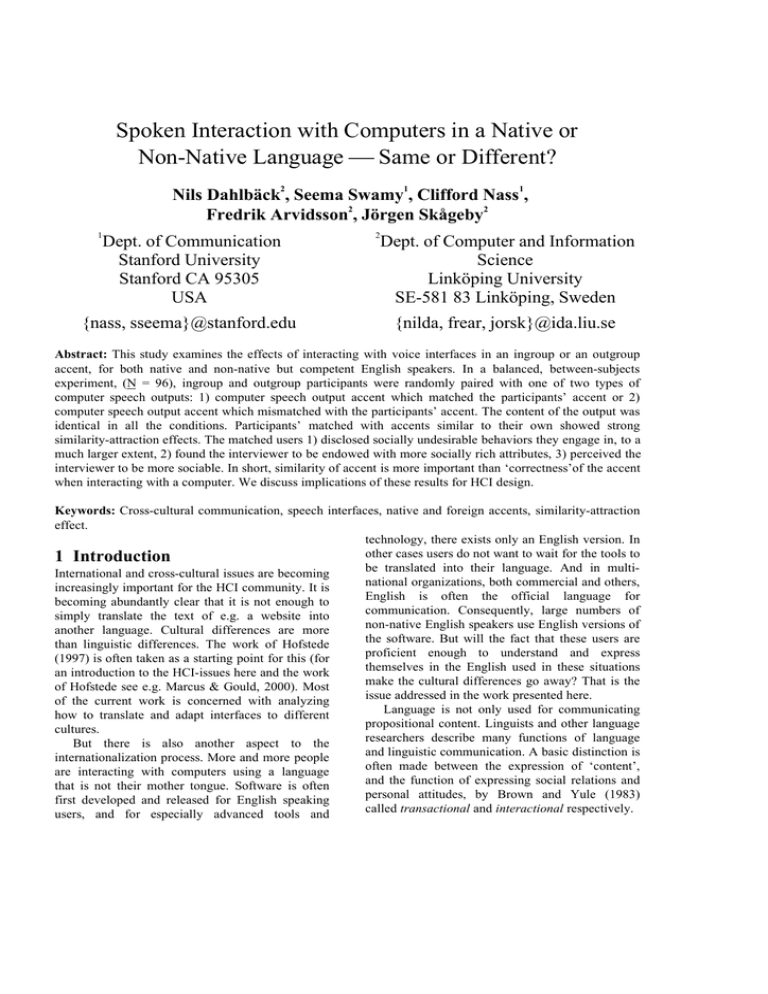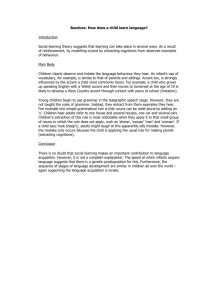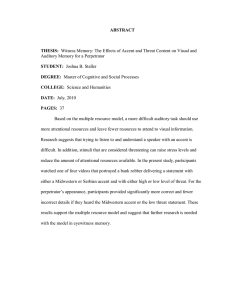Spoken Interaction with Computers in a Native or Non-Native Language
advertisement

Spoken Interaction with Computers in a Native or
Non-Native Language Same or Different?
2
1
1
Nils Dahlbäck , Seema Swamy , Clifford Nass ,
2
2
Fredrik Arvidsson , Jörgen Skågeby
1
Dept. of Communication
Stanford University
Stanford CA 95305
USA
{nass, sseema}@stanford.edu
2
Dept. of Computer and Information
Science
Linköping University
SE-581 83 Linköping, Sweden
{nilda, frear, jorsk}@ida.liu.se
Abstract: This study examines the effects of interacting with voice interfaces in an ingroup or an outgroup
accent, for both native and non-native but competent English speakers. In a balanced, between-subjects
experiment, (N = 96), ingroup and outgroup participants were randomly paired with one of two types of
computer speech outputs: 1) computer speech output accent which matched the participants’ accent or 2)
computer speech output accent which mismatched with the participants’ accent. The content of the output was
identical in all the conditions. Participants’ matched with accents similar to their own showed strong
similarity-attraction effects. The matched users 1) disclosed socially undesirable behaviors they engage in, to a
much larger extent, 2) found the interviewer to be endowed with more socially rich attributes, 3) perceived the
interviewer to be more sociable. In short, similarity of accent is more important than ‘correctness’of the accent
when interacting with a computer. We discuss implications of these results for HCI design.
Keywords: Cross-cultural communication, speech interfaces, native and foreign accents, similarity-attraction
effect.
technology, there exists only an English version. In
other cases users do not want to wait for the tools to
1 Introduction
be translated into their language. And in multiInternational and cross-cultural issues are becoming
national organizations, both commercial and others,
increasingly important for the HCI community. It is
English is often the official language for
becoming abundantly clear that it is not enough to
communication. Consequently, large numbers of
simply translate the text of e.g. a website into
non-native English speakers use English versions of
another language. Cultural differences are more
the software. But will the fact that these users are
than linguistic differences. The work of Hofstede
proficient enough to understand and express
(1997) is often taken as a starting point for this (for
themselves in the English used in these situations
an introduction to the HCI-issues here and the work
make the cultural differences go away? That is the
of Hofstede see e.g. Marcus & Gould, 2000). Most
issue addressed in the work presented here.
of the current work is concerned with analyzing
Language is not only used for communicating
how to translate and adapt interfaces to different
propositional
content. Linguists and other language
cultures.
researchers
describe
many functions of language
But there is also another aspect to the
and
linguistic
communication.
A basic distinction is
internationalization process. More and more people
often
made
between
the
expression
of ‘content’,
are interacting with computers using a language
and
the
function
of
expressing
social
relations
and
that is not their mother tongue. Software is often
personal
attitudes,
by
Brown
and
Yule
(1983)
first developed and released for English speaking
called transactional and interactional respectively.
users, and for especially advanced tools and
In most foreign language teaching the focus is
on the communication of content, and in many
countries the pupils reach an impressive level of
competence in transactional language use. But not
necessarily so for the interactional aspects,
especially since this is more closely related to the
cultural differences described by Hofstede and
others, and therefore more difficult to teach.
Furthermore, much of the interactional function is
communicated using intonation and other so-called
suprasegmental aspects of utterances that are
closely related to the accent of the speaker. And it
is well known that non-native patterns of speech
production is almost inevitable in the speech of late
second language (L2) learners (Flege, Munro &
Mackay, 1997) or non-native learners learning the
native language in non-native countries. Even
individuals that learn a second language as early as
3.1 years of age may have a foreign accent (Long,
1990).
Taken together, the facts above suggest that the
issues of cross-culture communication using a nonnative language become especially critical for
interfaces using spoken input and output. We have
therefore focused this study on the use of spoken
interaction with computers
1.2
Ingroup and outgroup accents
An accent acts as a cue identifying a speaker’s
group membership (Ladegaard, 1998). We form an
impression of speakers based on their speech
patterns and pronunciations (Giles, Williams,
Mackie & Rosselli, 1995). A basic distinction is
between an ingroup or an outgroup accent, where
an outgroup accent is an accent that sounds
distinctly dissimilar to the native speaker’s
pronunciation norms (Munro & Derwing, 1995).
We evaluate people as superior, inferior, fun, or
unattractive, based on their accents and stereotypes
about their nationalities (Cargile & Giles, 1997).
Stereotypes are mental concepts, pictures in our
heads which govern the process of perception
(Lippman, 1922), whether or not they represent
social realities. There often exists a tension between
the inherent value and the imposed norm of
stereotypes, i.e., between the objective social
reality and the constructed reality about people
belonging to a particular nationality.
The effects of foreign and other non-standard
language accents have been studied by researchers
in intercultural communication. The so-called
‘speaker evaluation paradigm’ (Ryan, Giles &
Sebastian, 1982) has studied the attitudes towards
speakers with different accent. The evaluative
reactions to speakers is here seen as a two-step
process – 1) listeners identify of the social group
membership from cues such as accent, age, race,
and gender and 2) derive specific stereotypes about
the speaker (Ryan, 1983). Two examples of this are
Giles et al’s (1995) work on the reactions to angloand hispanic-american accented speakers by US
participants, and Ladegaard’s (1998) work on the
perception of British, American, and Australian
language and culture in Denmark. The general
finding from these and other studies is that prestige
accented speakers are upgraded on traits of
socioeconomic success relative to non-standardaccent speakers.
Even when the content of the speech is entirely
understood, research shows that listeners
discriminate against the speakers with foreign
accent, display irritation, and exhibit prejudice in
other ways (Anisfeld, Bogo & Lambert, 1962,
Brennan & Brennan, 1981).
In addition, a combination of similarityattraction theory and proximate source orientation
(Nass & Lee, 2000), purports that when you match
the accent of the user with the accent of the speech
output, the user’s reactions should affect not only to
the voice but also to the speaker of the voice and
the interaction itself.
What the research within this paradigm,
however, does not address, are the actual effects, if
any, that these attitudes have on the actual
interaction. Does the interaction change merely
because the accent of the dialogue partner or
system is not the same as the speaker’s? In the
present study we have attempted to address both the
attitude and the behavioral aspect issues involved.
If changes occur, in which direction will they
be? There are two possible hypotheses here,
pointing in opposite directions. The work on
speaker evaluation described above suggests that
speakers will prefer to interact with speakers with a
native, and hence ‘correct’ accent. There is,
however, an alternative hypothesis, based on the socalled similarity-attraction effect. As humans we
prefer to interact with personalities that resemble
our own (Byrne & Nelson, 1965). This is true also
for computer interfaces (Nass & Lee, 2000, Ibister
& Nass, in press). If we hypothesize that the
similarity attraction effect also is true for other
attributes than personality, this suggests that
speakers will prefer to interact with a speaker with
an accent similar to their own.
Which one of these hypotheses is the correct
one is not only of theoretical interest. It has obvious
practical implications for the HCI-community. If a
native or ‘correct’ accent is the most positively
valued accent for both native and non-native users
of the software, software providers can with
confidence use English only software also for that
large and growing user population that has a good
command of English as a second language. But if
native and non-native users react differently to this
accent, the issues of how to make software
available to an international audience becomes even
more important than what has hitherto been thought
to have been the case.
In the present study we have addressed these
questions by having both native and non-native
users interact with a computer system using spoken
input and output, where the computer’s language
also has either a native or a non-native accent,
similar to the non-native users’ accent.
2 Experiment
2.1
Method
The experiment was a full-factorial 2 (participants’
nationality: American and Swedish) x 2 (computer
speech output: American accent and Swedish
accent) balanced, between-participants design. For
each of the nationalities, a male voice and a female
voice of a graduate student in each country was
recorded. All recordings from both countries were
in English.
The Swedish speakers of English were all native
Swedish speakers with Swedish speaking parents.
They had taken English as their first foreign
language in school, which they had taken for
approximately 8 years. They used English as a
professional second language, both written and oral.
Their pronunciation was closer to US English than
e.g. British or Australian, but they had a noticeable
Swedish accent. This was not, however, so strong
that it impeded the understanding of their speech.
(Samples of the voices can be found at
http://www.ida.liu.se/~nilda/voices.html.)
Gender of output was balanced across condition,
so that half of the participants in each condition
heard a male voice and half heard a female voice.
Similarly, all conditions were balanced for gender
of participants.
To administer the experiment, we used the
CSLU Toolkit for presenting the voices and
recording and recognizing participant responses.
(For more information on the CSLU Toolkit, see
http://cslu.cse.ogi.edu/toolkit/.)
2.2
Participants
Participants were 96 Caucasian students; 48
American students enrolled in an undergraduate
class in a U.S. university and 48 Swedish students
enrolled in undergraduate classes in a Swedish
University.
All of the U.S. students were native speakers of
English. All the Swedish participants were born in
Sweden by Swedish speaking parents. They had
taken English as their first foreign language in
school, which they had studied for 7-9 years, with
approximately 2-3 lessons a week. We excluded all
participants who had lived for longer periods in an
English speaking country as a child or as an
exchange student, but shorter visits, for instance on
holiday, were accepted.
The Swedish participants could all use English
in casual conversations, and most of them were
used to using textbooks and other literature in
English in their university studies.
Since we did not want the participants to focus
on the fact that the study was interested in effects of
the fact that they had to interact with a computer in
English, we screened the participants only after the
participation in the experiment. 17 participants
were excluded because they did not match these
criteria, and are therefore not included in the
figures presented here.
The ages of the participants ranged from 18
years to 24 years. The US participants received
course credit for participating in the experiment,
while the Swedish participants were paid two movie
tickets for their participation. The participants were
randomly assigned to the four conditions, with
gender of participant and gender of voice balanced
across conditions.
2.3
Procedure
Upon arrival, participants were required to read a
consent form and sign it. Participants were assured
that the information submitted was confidential.
Each participant was fitted with a hands-free
microphone to respond to the questions posed by
the computer. The voice from the computer was
audible through two speakers placed on either side
of the computer. The experimenter demonstrated
the manner of interaction by walking each
participant through the practice round. The practice
round consisted of three questions similar to the
actual interaction.
The first round asked questions derived from the
BIDR-Impression Management (IM) subscale
(Kroner, & Weekes, 1996). The original 20 BIDR
items were first-person statements, for example, "I
sometimes tell lies if I have to". To suit the
interview nature of this study, the items were
adapted to "Do you" or "Have you" questions, such
as "Do you sometimes tell lies if you have to?" “Do
you gossip about other people’s business?” “Do you
ever take things that don’t belong to you?” “Do you
ever read sexy books or magazines?” The computer
screen displayed the numbers 1-7 on separate
buttons, with anchors of “not true” and “true,”
respectively (consistent with the original BIDRIM).
To respond to this scale, the participants spoke
the number corresponding to their response for each
of the questions. The number spoken by
participants in response to a question asked by the
computer lit up yellow as a confirmation of the
participants’ input.
The second round asked questions from Moon’s
(1998) nine self-disclosure questions. A few
example questions include: “What do you dislike
about your appearance?” “What are some of the
things that make you furious?” and “What
characteristics of your friend really bother you?”
These are open-ended questions.
Participants
dictated their answers to the system; although they
believed that the system recognized their responses,
in fact they were simply recorded for later analysis.
The system continued recording until the
participant stopped answering the question.
Participants were allowed to listen to all
questions as many times as they wished by saying
the word “repeat.” After responding to a question,
participants could either proceed to the following
question by saying “next” or go back to the
previous question to change their response by
saying “back.” English was used for both questions
and answers for all participants, both American and
Swedish.
After the participant had answered all the
questions, a screen with a message thanking the
participant for their participation popped-up and the
participant was instructed to complete a paper-andpencil questionnaire placed on the other side of the
room. After the questionnaire was completed, the
experimenter
thanked
and
debriefed
the
participants.
2.4
Measures
The BIDR-IM is constructed so that higher scores
indicate less self-disclosure. The 20 items were
organized into a single index (Cronbach’s alpha =
.81).
A second measure for self-disclosure was based
on the number of words spoken in response to
Moon’s (1998) self-disclosure questions. The index
was highly reliable (Cronbach’s alpha = .72).
The
closed-ended
paper-and-pencil
questionnaire was divided into four sections. The
two sections asked how well a list of adjectives
described the interviewer and the interview, and the
participant’s feelings during the interaction. Each
adjective was associated with a 10-point Likert-type
scale anchored by “Describes Very Poorly” (=1)
and “Describes Very Well” (=10).
Based on theory and factor analysis, we created
three indices from the questionnaire. All indices
were very reliable
Social Richness index was comprised of eleven
items describing the interviewer: warm, lively,
vivid, personal, accessible, sensitive, immediate,
emotional, friendly, responsive, and sociable
(Cronbach’s alpha = .86).
Liking of the interview was an index of five
items: friendly, likable, nice, and pleasant (alpha =
.85).
Sociableness was an index of five items
describing the interviewer: friendly, likable,
outgoing, pleasant, sociable, and warm (alpha =
.85).
We asked all the Swedish participants whether
there were any words they did not understand in the
questions they were asked. For only 8 of the 1920
(0.4 %) questions asked were the Swedish
participant uncertain of the meaning of a word, and
only one participant asked for more than one word.
3 Results
All results are based on a full-factorial ANOVA.
Controls for gender of participant and gender of
voice did not have substantive effects on our
conclusions, so they are not reported here.
3.1
Manipulation Check
All participants correctly identified the computer
output accent as belonging to their nationality
(ingroup) or a different nationality (outgroup). They
did not, however, in all cases identify the outgroup
accent correctly.
3.2
Balanced Inventory of Desirable
Responding
.063, p < .02, but this finding was an artifact of the
interaction.
There was a significant cross-over interaction effect
2
with respect to the BIDR-IM, F(1, 92) = 3.93, η =
.04, p =.05, consistent with similarity-attraction
(see Figure 1). Participants provided more honest
responses to their ingroup accent as compared to
the outgroup accent.
3.4
Social Richness
There was a significant cross-over interaction with
2
respect to social richness, F(1, 92) = 4.70, η = .03,
p < .05, consistent with similarity attraction (see
Figure 3). U.S. participants found the U.S. voices
to
&IGURE "ALANCED )NVENTORY OF $ESIRABLE
&IGURE 3OCIAL 2ICHNESS
2ESPONDING
3,6
4
3,4
3,5
3,2
3
American Participants
American Output
3
Swedish Participants
American Output
Swedish Output
American Participants
Figure 1: Balanced Inventory of Desirable Responding.
3.3
Moon’s Self-Disclosure Items
There was no interaction between participant
nationality and output nationality, F(1,92) = 2.15,
2
η = .02, p > .14 (see Figure 2). Americans did
2
exhibit similarity-attraction, F(1,46) = 4.5, η = .09,
p < .04, but there was no effect for the Swedish
2
participants, F(1,46) = 1.90, η = .04, p > .17. The
American participants spoke significantly more to
the interface than did Swedish participants, F(1,92)
Swedish Output
Swedish Participants
Figure 3: Social Richness
be more socially rich, while Swedish participants
found the Swedish voices to be more socially rich.
There were no main effects for participant or voice
nationality.
3.5
Liking of the interview
There was a significant cross-over interaction effect
with respect to liking the interview, F(1, 92) = 9.25,
2
η = .07, p < .01 (see Figure 4). Consistent with the
&IGURE ,IKING OF THE INTERVIEW
&IGUR E 7OR D #OUNT ON /PEN%NDE D )TE MS
6
12
10
5
8
4
6
3
4
American Output
American Participants
S wedish O utput
S wedish Participants
American Participants
American Output
Swedish Participants
Swedish Output
Figure 2: Word Count on Open-Ended Items.
Figure 4: Liking of the Interview
= 114.1, η = .554, p < .001. There was a significant
2
effect for nationality of output, F(1,92) = 6.19, η =
previous results, Swedish participants liked the inter
view more when it was in a Swedish accent while
2
U.S. participants liked the interview more when
presented in a U.S. accent. There were no main
effects.
3.5
Sociableness of the interviewer
There was a significant cross-over interaction with
respect to sociableness of the interviewer, F(1, 92)
2
= 17.58, η = .16, p < .001 (see Figure 5). Once
again, the results were consistent with similarityattraction theory, as U.S. participants found the
U.S. voice more sociable, while Swedish
participants found the Swedish voice to be more
sociable.
& IG U R E 3 O C IA B L E N E S S O F T H E IN T E R V IE W E R
5 .5
4 .5
3 .5
Am erican O utp ut
Am erican P articipants
S wed ish O utput
S wedish Particip ants
Figure 5: Sociableness of the Interviewer
4 Discussion
The central question addressed in this work is
whether computer users prefer interacting with
spoken interfaces using a native and correct accent,
or whether they prefer computers with an accent
similar to their own. Our results clearly show an
ingroup preference. While the content of the output
was identical in all the conditions, when
participants’ were matched with accents similar to
their own they: 1) disclosed socially undesirable
behaviors they engage in, to a much larger extent,
2) found the interviewer to be endowed with more
socially rich attributes, 3) perceived the interviewer
to be more sociable
Similarity-attraction theory provides a clear
explanation for the interaction effects for the
indices BIDR, Lombard’s social richness scale,
likability, and perception of sociability of the
interaction where participants respond positively to
speech output in an accent similar to themselves.
This is supported by similar findings in a study,
which found that participants are positively
influenced by ingroup members (Nass & Lee,
2000).
That American users should prefer systems with
an American accent is perhaps not all that
surprising. But our results also suggest that the
many computer users around the world that interact
with computers in English, despite not being native
English speaker, will prefer their own ingroup
accent, even if a native accent has higher prestige
and status. Whether this is true also for other
cultural groups than those studied here, remains of
course a question for further work.
The Swedish participants in our study did not
experience any problems in using the system, or in
performing the task. In fact, not one single Swedish
participant expressed any surprise when they found
that the study required them to interact with the
system in English instead of Swedish. They have all
done this often before, and are used to the situation.
But even if they experienced no problems in
using the system, or performing the task, they did
not react to the system like native English speakers.
Our results therefore clearly indicate that issues of
cross-cultural communication and issues of
internationalization of software will remain, also
for those non-native English speakers that can
perform reasonably well in transactional aspects of
communication.
What are then the consequences of our results
for the HCI community, and especially for
designers of spoken interfaces? When addressing
the needs for native English speaking users the
implications
seems
rather
straightforward.
Designers should use the accent that is the most
widely accepted as the standard accent within the
nation. Unless, of course, they in specific instances,
for games and other forms of entertainment,
actually want to create an outgroup reactions in the
users. In this case our results show that also
relatively small changes can create effects in users.
When, on the other hand, we come to the
consequences of our results for all those users of
English-based speech software, that are not native
English speakers, it is less clear what the
recommendations should be. The closest parallel to
the situation in English speaking countries would be
to suggest that the software should speak with the
accent of the users. But creating English with a
Swedish accent for Swedish users, a French accent
for French users, etc., sounds like a rather odd
recommendation.
In some cases, especially when using
synthesized speech, and when no native language
synthesis exists, this might of course actually be the
best solution. But clearly more research is needed
to clarify the issues involved here. We have here
focused on English, since English is becoming a
lingua franca in much international work. And we
have studied users from two countries that are
similar in many respects. It is interesting to note
that despite these similarities in culture, we find
similarity-attraction effects of accent here. While
one single study like the one presented here can not
illuminate all the issues involved, the work
presented here indicates that cross-cultural issues in
spoken interfaces is an important area of future
research.
Acknowledgements
This research was supported in part by SITI
(The Swedish Research Institute for Information
Technology) through its e-Society program, and the
Swedish Graduate School for Human-Machine
Interaction.
References
Anisfeld, M., Bogo, N., & Lambert, W. (1962).
Evaluational reactions to accented English speech.
Journal of Abnormal Social Psychology 69, 89-97.
Brennan, E. & Brennan, J. (1981). Measurements of
accent and attitude toward Mexican American
speech. Journal of Psycholinguistic Research 10,
487-501.
Brown, G. & Yule, G. (1983) Discourse analysis.
Cambridge University Press, NY.
Byrne, D & Nelson, D. (1965) Attraction as a linear
function of proportion of positive reinforcements,
Journal of Personality and Social Psychology
Bulletin, 4, 240-243.
Hofstede, G. (1997) Cultures and Organizations:
Software of the Mind, McGraw-Hill, New York.
Ibister, K. & Nass, C. Consistency of personality in
interactive characters: verbal cues, non-verbal cues,
and user characteristics. International Journal of
Human-Computer interaction, in press.
Kroner, D. G. & Weekes, J. R. (1996), Balanced
inventory of desirable responding: Factor structure,
reliability, and validity with an offender sample.
Personality and Individual Differences, 21(3), 323333.
Ladegaard, H.J. (1998). National stereotypes and
language attitudes: The perception of British,
American and Australian language and culture in
Denmark. Language and Communication 18, 251274.
Lippmann, W. (1922) Public Opinion. The Free Press,
NY.
Long, M. (1990). Maturational constraints on language
development. Study of Second Language Acquisition
12, 251-285.
Marcus, A. & Gould, E. W. (2000), Crosscurrents:
Cultural Dimensions and Global Web UserInterface Design. Interactions VII (4), 32-46.
Moon, Y. (1998) Intimate self-disclosure exchanges:
Using computers to build reciprocal relationships
with consumers. Working Paper for Harvard
Business School, 1998
Munro, M.J. & Derwing, T.M. (1995), Processing time,
accent, and comprehensibility in the perception of
native and foreign-accented speech. Language and
Speech 38, 3, 289-306.
Cargile, A.C. & Giles, H. (1997). Understanding language
attitudes: Exploring listener affect and identity.
Language and Communication 17, 3, 195-217.
Nass, C. & Lee, K.M. (2000). Does Computer-Generated
Speech Manifest Personality? An Experimental Test
of Similarity-Attraction. Proceedings of CHI ’00,
(Amsterdam, April 2000), ACM Press, 329-336.
Flege, J., Munro, M., & Mackay, I. (1997). Factors
affecting strength of perceived foreign accent in a
second language. Journal of Acoustical Society of
America 97 (5), 3125-3134.
Ryan, E. B. (1983). Social psychological mechanisms
underlying native speaker evaluations of non-native
speaker. Studies in Second Language Acquisition 5
(2), 148-159.
Giles, H., Williams, A., Mackie, D.M., & Rosselli, F.
(1995). Reactions to Anglo- and HispanicAmerican-accented speakers: Affect, identity,
persuasion, and the English-only controversy.
Language and Communication 15, 2, 107-120.
Ryan, E. B., Giles, H. and Sebastian, R. J. (1982). An
integrative perspective for the study of attitudes
toward language variation. In Ryan. E. B. and Giles.
H. (Eds). Attitudes Toward Language: Social and
Applied Contexts. Arnold, London.








